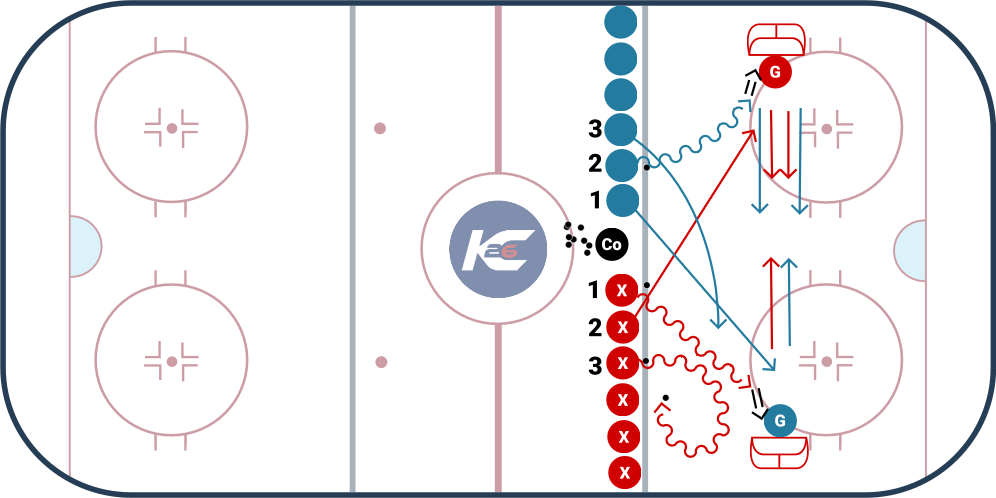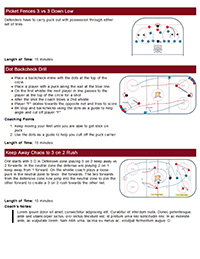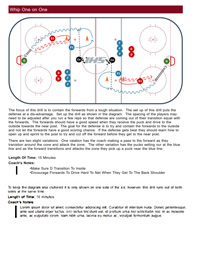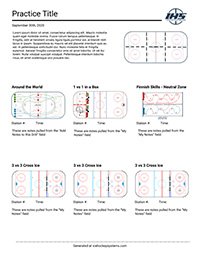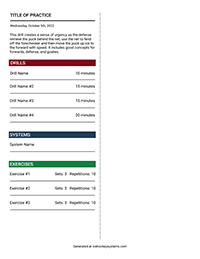Cutting Hands & 1 v 1 Net Drives
Cutting Hands & 1 v 1 Net Drives

Please Note: The Practice of the Week is designed to bring value across multiple age levels. You can use this to build ideas to develop your own practice. With that being said, we highly encourage you to adjust the drills based on your team's age and skill levels. IHS should always be used as a starting point and you can add/remove constraints to fit your team.
Practice Theme: Cutting the hands of the defender is a great way to invade their space which allows you to protect the puck and gives you space to make a play. Once a player has a step on the defender while driving to the net they need to take the defense's hands away by cutting to the inside. This takes away the angle where the defense can recover. If the offensive player uses their body to take away the defense's hands then they also eliminate the ability for the defense to go stick on puck. This practice plan emphasizes using this skill in different situations with a focus on net drives. It's also a great practice to work on defensive angling.
3 Key Focus Points
- Gain a Step on your Defender - work to gain a step on your defender by reading their angle and using speed or change of speed
- Cut the hands of the defender - invade the defenders space by moving your body into the defenders hands to protect the puck and drive the net
- Defensive Angling - Lead with your stick and take an angle that limits options for the attacking player and finish through their hands
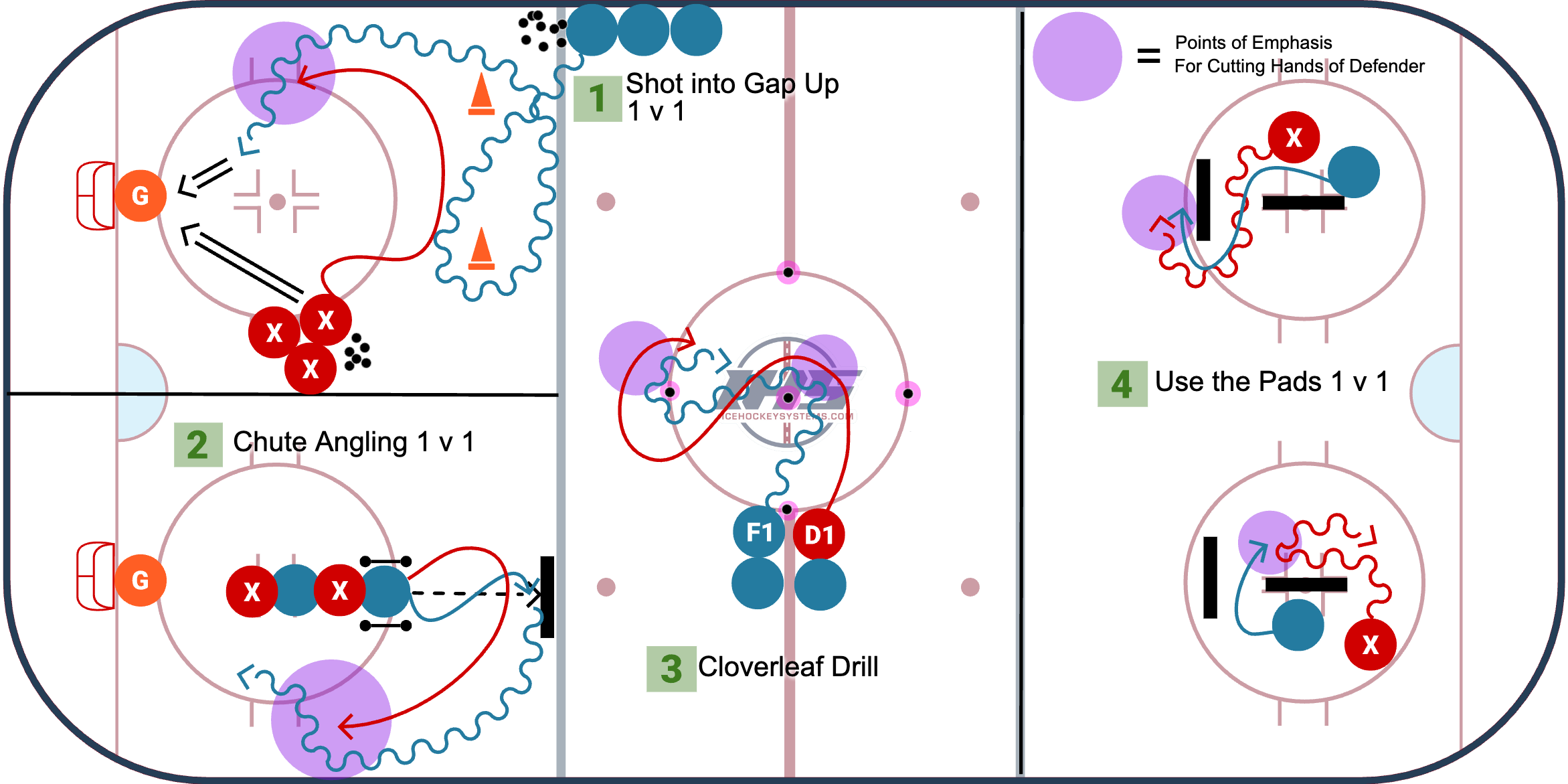
Cutting Hands Warm-Up
The Cutting Hands Warm-Up from TJ Manastersky, Head Coach of Brock University allows players to practice offensive puck protection, and escape techniques along with defensive angling concepts.
Setup
- Set up two lines by the neutral zone face-off dot on opposite sides of the rink.
- On the whistle, the player along the boards takes a puck and skates up the boards.
- The player on the inside of the ice acts as a backchecker and takes and angle to lift their stick and take the puck from them. This player then takes the puck and practices deception and escape to head back up ice.
- As the puck carrier returns back up ice, they practice getting off of the wall with the puck and cutting the defenders hands to protect the puck as they head up ice.
- They then pass the puck to the next player in line and the drill is continuous.
Coaching Points
- The backchecker should work to take a proper angle on the puck carrier and lift their stick to remove them from the puck before taking the puck away. After gaining possession they should practice a deceptive fake before transitioning back up ice and cutting the defenders hands.
- Defenders should keep their sticks on the ice at all times as a habit to block passing lanes and work on good angling technique.

Shot Into Gap Up 1 v 1
Shot Into Gap Up 1 v 1 lets players work on driving the net, along with angling in a tight space.
Setup
- Set the net up below the face-off circle on the goal line.
- Set up 2 lines, one on the outside of the face-off circle in the slot, one at the blueline.
- On the whistle, the player close to the slot takes a shot, while the player at the blueline explodes into the zone and goes around the far cone.
- The player that took the shot works to gap up and angle the player coming in from the blue line.
- Play out the 1 v 1.
- Make sure players get reps at both sides.
Coaching Points:
- Defender:
- Gap up and match the offensive skaters speed.
- Keep your stick on the ice and angle them towards the boards, do not let them cut back into the middle of the ice.
- Go stick on puck and finish through their hands to remove the puck from their stick.
- Offensive skater:
- Keep your head up and look for an opportunity to cut back into the middle of the ice.
- If there is no space, keep feet moving and try to protect the puck along the boards and drive to the net.

Chute Angling 1 V 1
Chute Angling 1 v 1 is a fun drill that allows offensive players to practice deceptive retrievals while a defender works to angle them away from a scoring chance.
Setup
- Set the net up below the face-off circle on the goal line.
- Players line up on top of the face-off circle.
- On the whistle, the second player in line shoots the puck up towards the blue line, either hitting a pad, or a coach's stick.
- The first player in line skates up to the puck and works to deceive the second player in line before they retrieve it.
- When the puck is picked up the 1 v 1 starts and the defender is working to take the puck away and skate past the blueline, while the puck carrier works to score.
Coaching Points
- Defender:
- Gap up and match the offensive skaters speed.
- Pay attention to their body, not their head or skates.
- Keep your stick on the ice and angle them towards the boards, do not let them cut back into the middle of the ice.
- Go stick on puck and finish through their hands to remove the puck from their stick.
- Offensive skater:
- Use deception with your skates, legs, body and head to try to throw off the defender.
- Keep your head up and look for an opportunity to cut back into the middle of the ice.
- If there is no space, keep feet moving and try to protect the puck along the boards and drive to the net.
Variations
- Can set up to be 1/4 ice or 1/2 ice
- Can set up in different areas of the ice
- Can bounce the puck off of a pad, bumper, coach, player, or boards
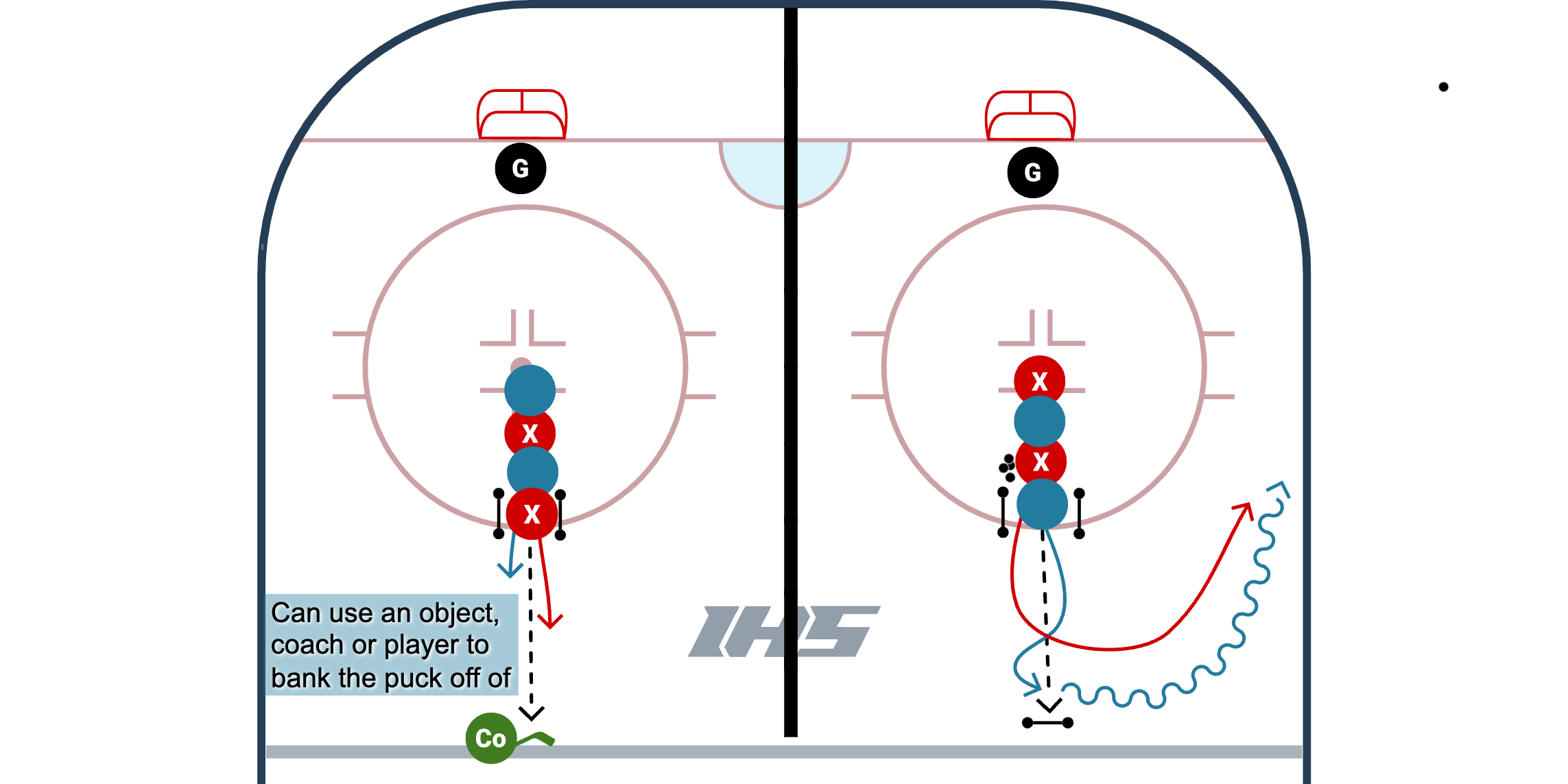
Cloverleaf Drill
The Cloverleaf Drill shared by TJ Manastersky, Head Coach of Brock University, allows players to work on their puck protection and tight turn skills in a simple setup around a circle. In this particular variation of the Cloverleaf, there will be a defender following the puck carrier and presenting passive stick pressure. At the bottom, we will link to more variations.
Setup
- Setup 4 pucks around the face-off circle with one puck in the face-off dot that players will use to skate around. Can also use tires, cones, or nothing at all.
- On the whistle, a player with the puck will skate around the "cloverleaf." The puck carrier will go around the center face-off circle and then around each of the other pucks.
- After the puck carrier goes around a puck on the outside of the face-off circle, they must return and go around the puck in the face-off dot.
- A defender follows the puck carrier and presents passive stick pressure that the puck carrier can use to practice "cutting hands" puck protection techniques.
Coaching Points
- The puck carrier should cut the defenders hands to take their stick out of the play.
- The puck carrier should use a low stance and use their body to further create space and separation from the defender.
Variations
- Coaches can allow puck carriers some reps without a defender to dial in the movement if they are unsure of the drill and skill.
- Can use a defender (like shown above) or the defender can be in the middle of the circle as shown on this variation by NextGeneration HKY.

Use the Pads 1v1 Keep Away
DRILL SETUP:
- Set up 2 nets or divider pads perpendicular with space in between
- You can set up 3 per zone if needed
- It's a 1 v 1 drill and they are just trying to play keep away from each other and use the nets (or pads) to work on their angling
DRILL PURPOSE:
- Reading Pressure
- Change of direction and escapes
- Puck Protection in open space
- Angling in tight spaces

Breakaway Backcheck With 1 on 1 Variation
The video above will start with the breakaway backcheck drill and then will show how the drill can be modified to be a 1 on 1 with a backchecker (at the 1 minute 20 second mark).
Drill Setup:
- Players are split into 2 lines. Offensive line (with pucks) is near the wall and ahead of the blue line. The defensive line starts more toward the middle and behind the blue line.
- The idea is the offensive player has a step but the defensive player has the angle (closer/more direct line to the net). When coach says go it is a race. The offensive player is trying to get to the net while the defensive player is trying to cut them off. Play the puck out.
Drill Purpose:
- The purpose of this drill is to allow players to work both sides of the playing in contact skills.
- Defensive in terms of trying to get in front of and gain position on an offensive player.
- Offensive in terms of trying to cut a defender off and not allowing them to gain position on you.
Variations:
- This drill can start from anywhere on the ice in this same format of giving the offensive player a step but defensive player the angle. Scenario outlined above is a back check type situation. This drill could also be setup coming out of the corner or maybe a shorter distance like the near blue line, instead of far blue line. Rules: At first I usually do not allow offensive player to use an escape turn to protect the puck. It is either gain body position or lose the puck. I want them to really have to work on gaining body position and get to the net versus a turn to evade pressure. After a time I usually then will say turns are allowed but should only be used if the defender was able to gain position on you. A turn should should not be option #1. Option#1 should be use your play in contact skills, cut the defender off and gain the net.
- Second video example: Set up the drill but include a defenseman so it is a 1 on 1 with a backchecker. The forward needs to cut the backchecker off and work to gain position on the 1 on 1.
Common Mistakes:
- As the defender, the biggest mistake is player goes directly for the puck instead of hitting through the hands and poking / taking the puck. Stress body contact combined with stick poke or lift to gain position (position before possession). Offensive side the biggest mistake is the offensive player skates away from the defender (usually toward the corner) versus skating into and cutting off the defender. Stress that by skating away from the defender you are taking yourself out of a scoring chance situation / area (middle of rink) and giving the defender the chance to hit you as they now are able to re gain and angle you off into boards.
This drill is part of the Body Contact & Checking Course from Mark Zarbo Hockey.
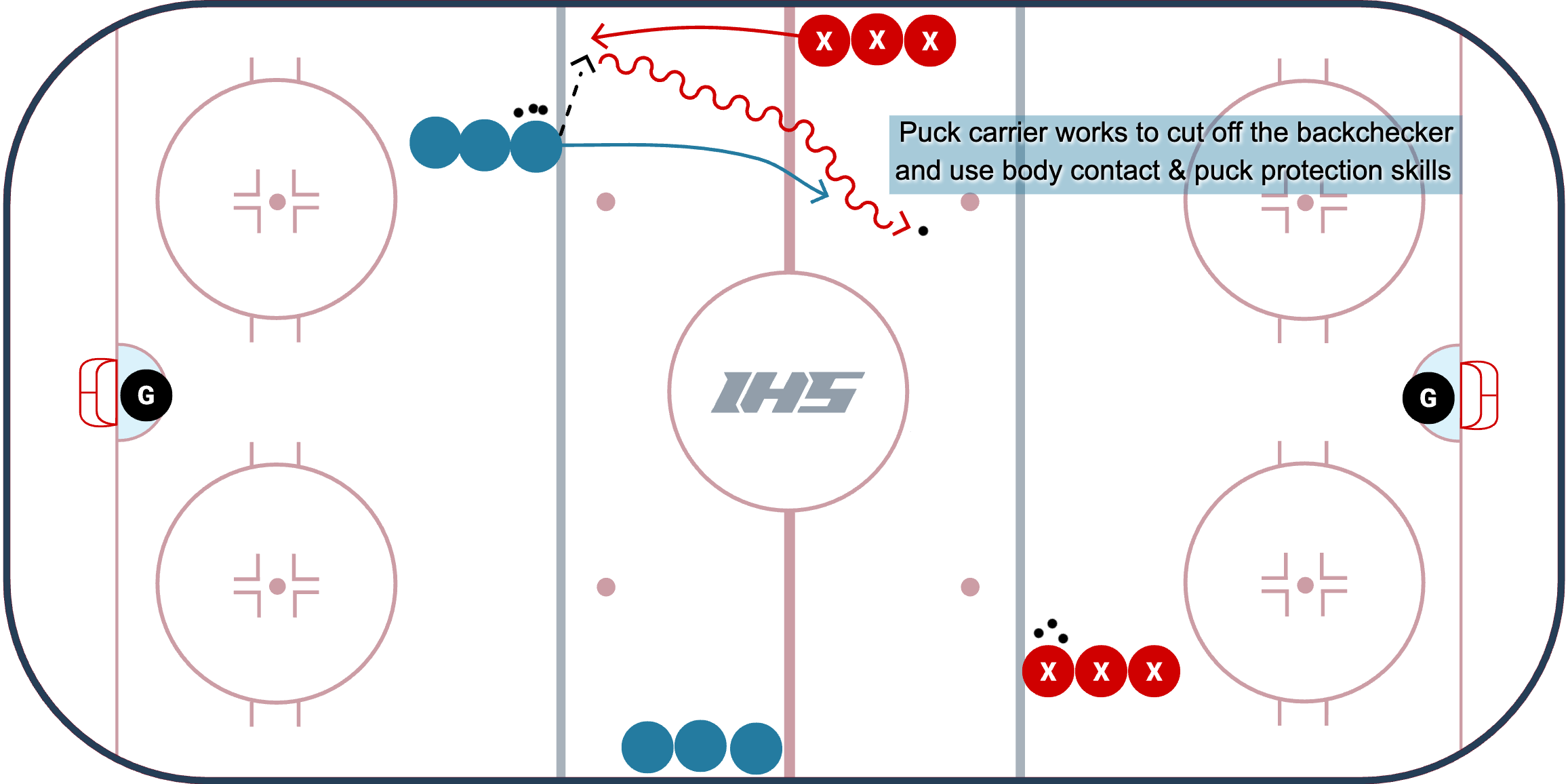
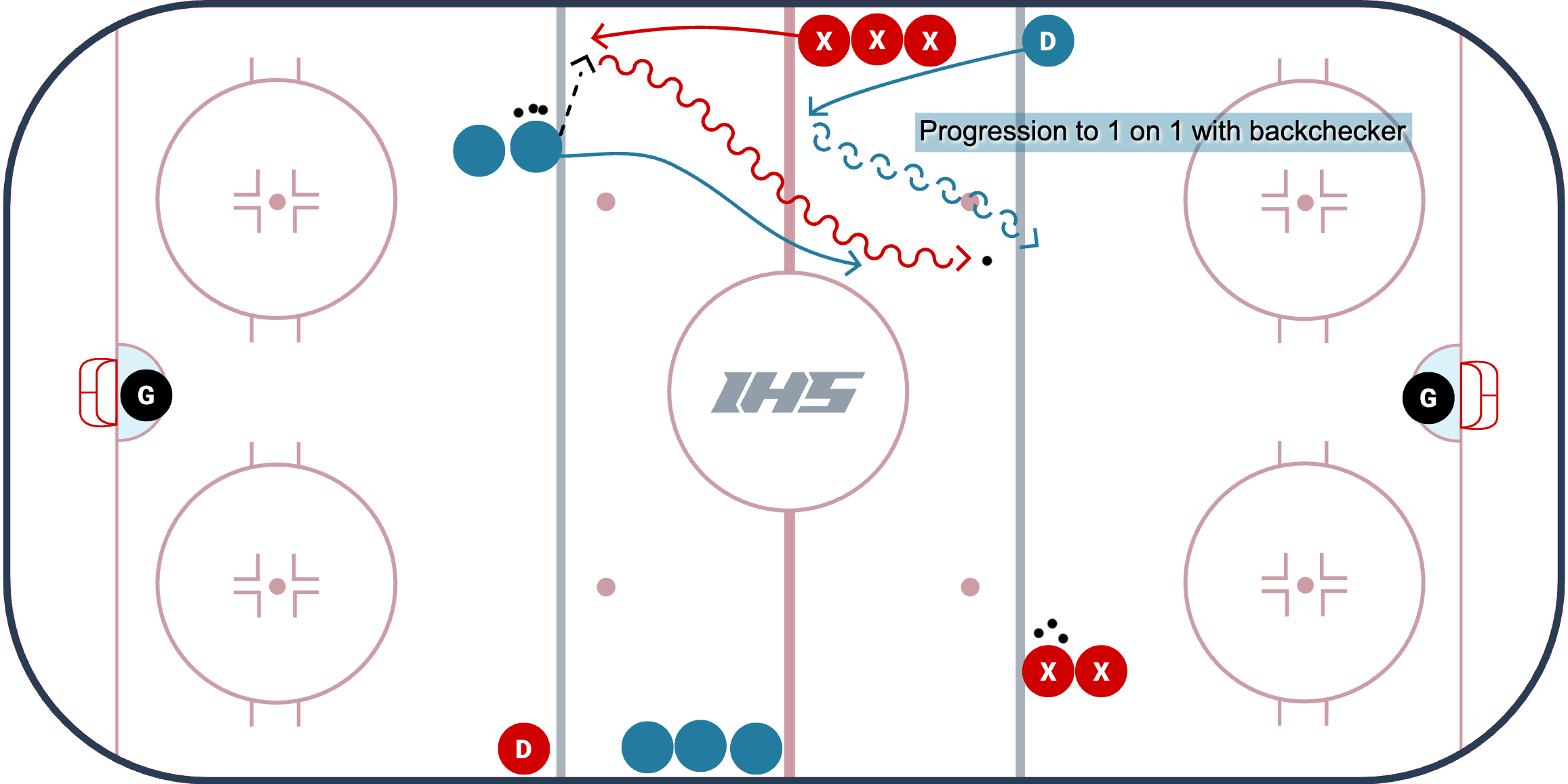
1 v 1, to 2 v 2 to 3 v 3
Description
This quick paced small area game from Kendall Coyne Schofield gets a lot of players moving and is great to work on goal scoring when there is back pressure.
Set Up
- Set up 2 nets on the half wall in one of the zones
- A goalie is defending each net
- Team "X" and Team "O" should be lined up on the blue line on one side
- Make sure there is at least a 10 ft space between the teams on the blue line
- There should be pucks lined up for each team near the center of the blue line
Game
Play up to a certain amount of goals, team "X" vs team "O"
- On the whistle, player 1 from team O skates in on a mini breakaway
- Player 1 from team X leaves on the same whistle to apply back pressure on the player from team O
- On the second whistle player 2 from team X skates in on a mini breakaway while player 2 from team O applies the back pressure
- On that same second whistle, player 1 from both team X and team O join the rush to make it a 2 v 2
- On the third whistle player 3 from team O skates in on a mini breakaway while player 3 from team X applies the back pressure
- On that same third whistle, players 1 and 2 from both teams join the rush to make it a 3 v 3
- Coach can blow the whistle whenever they see fit
- Make sure the team who starts with the puck switches after every rep to keep it fair
- Keep score!
Coaching Points
- Scoring Under Pressure - players need to control the puck and get to the net and shoot quickly
- Escaping Pressure - when your teammates join the rush you can make the decision to escape pressure and find the players joining the rush
- Applying Pressure - working hard to apply pressure to your opponents trying to score
